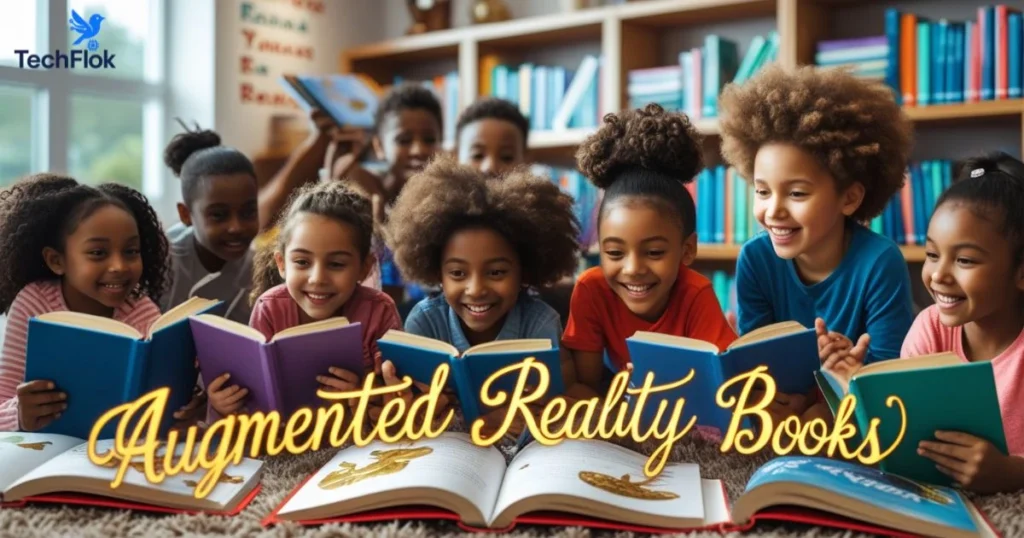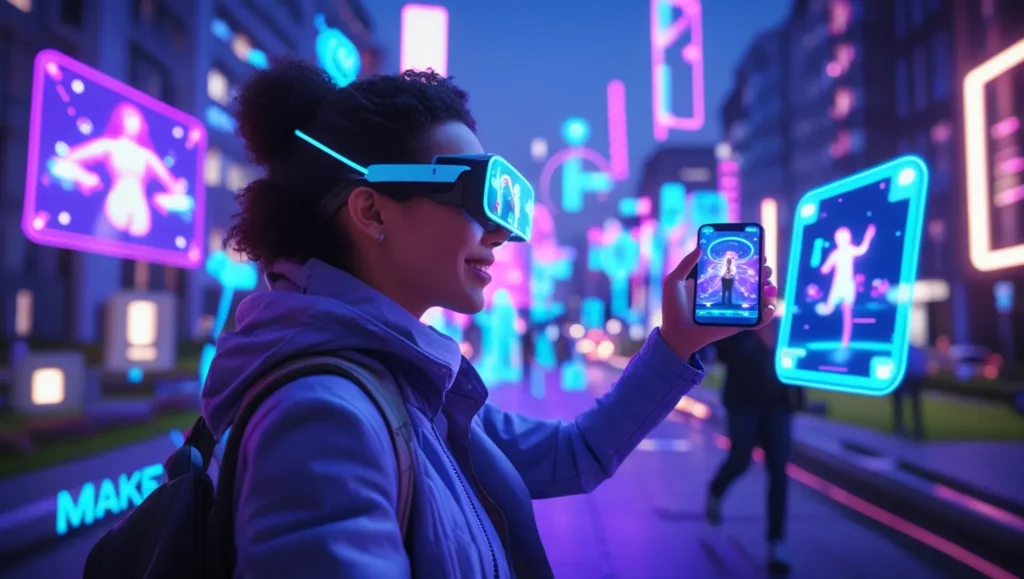
What are Augmented Reality Books?
Augmented reality books are a combination of traditional printed material and digital information. It is an advanced digital approach for readers and users. These books enhance the experience of readers, which becomes possible through technology. Readers don’t just read, they experience.
AR books don’t just tell stories, they show them, move them, and make them part of your world. Whether you’re a curious kid, an educator, or a tech-savvy reader, this blend of words and wonder changes how we connect with stories and ideas. With a phone or tablet, interactive books can become 3D, launch sounds, or even guide you through historical events. Welcome to the future of reading: immersive, exciting, and unforgettable.
How Does Augmented Reality Work in Books?
AR books use augmented reality technology like marker-based tracking or non-marker-based AR. When you open a book and point your device at a page, special markers (or images) trigger digital content to display on your screen.
The technology behind this includes a graphical user interface (GUI), often combined with a tangible user interface (TUI). Tools like ARKit / ARCore help developers build this magic. Some AR books also work with head-mounted displays (HMDs) for a more immersive experience.
Core Components of Augmented Reality Books
Every AR book contains specific elements that create the immersive experience. These include:
Component Description
Trigger Images Pages that activate AR when scanned
AR App: A book scanning app or reader tool
3D Content: Characters, environments, or models
Sound & Narration Background audio, music, or spoken text
All these components offer real-time interaction with the book, turning static text into dynamic content.
Reading Experience with AR Books
Reading Augmented Reality books feels like stepping inside a story. You turn a page, and suddenly a dragon flies out, or a science experiment begins on your screen. This interactive storytelling approach makes learning and entertainment more engaging.
1. Interactive storytelling is one of the biggest benefits of AR books
The multi-sensory learning experience draws in children and adults alike. You see, hear, and even interact with characters and environments. This new style of reading is changing how we engage with digital books.
Benefits of Augmented Reality Books in Education
In classrooms, Augmented Reality education tools are transforming how students learn. They allow teachers to use student engagement tools to bring abstract ideas to life. Imagine teaching anatomy where students can explore 3D organs on their desks.
2. Multi-sensory learning is supported by
AR-enabled textbooks, learners can benefit from visual learning tools that break down complex ideas. Subjects like biology, history, and geography become more accessible and exciting. AR supports interactive learning environments where students can explore at their own pace.
Real-Life Applications of AR Books Across Industries
Outside of schools, augmented reality in publishing is used in tourism, medicine, and marketing. Travel guides now show 3D monuments. Medical AR books explain surgeries using 3D books with moving illustrations.
Even in fashion or cooking, AR offers enhanced textbooks that guide users with step-by-step instructions.
3. Educational AR experiences improve understanding by combining theory with demonstration
Augmented Reality in Children’s Books

Kids love stories that come to life. Animated children’s books with AR spark imagination and curiosity. Interacting with characters makes them more likely to stay focused and develop a love for reading.
4. Gamified learning materials mix fun and learning
Books like these are ideal for gamified learning materials. They mix fun and learning, turning bedtime stories into interactive books that boost language, creativity, and attention.
Case Study: Squixy and the Dream It! AR Book
Squixy is an AR-powered workbook designed to make math and STEAM subjects fun. When students open the book and scan images, they see Squixy come to life, helping them solve problems and play games.
Another hit is Dream It!, where a character named Donkey Corn appears in 3D. Children can spin, move, and explore this magical creature using a simple book-based AR app. It’s not just fun, it teaches problem-solving and boosts memory.
5. Real-time interaction allows kids to actively participate, not just watch.
Technologies Behind Augmented Reality Books
Creating AR books involves a mix of software and creativity. Developers use ARKit / ARCore, game engines like Unity, and design tools to build these experiences. The goal is smooth, responsive, and engaging content.
These books work on smartphone-based AR platforms, but more advanced versions support head-mounted displays (HMD) or tablets with tangible user interfaces (TUI). Developers also focus on making everything work with real-time interaction and fast loading.
Device and App Compatibility for AR Books
Today’s book-based AR games work on most smartphones and tablets. As long as your device supports mobile AR applications, you can enjoy the experience. Some books need specific apps, while others use generic AR readers.
Compatibility also depends on the book scanning app used. These apps are designed for digital overlays and must support high-resolution scanning. Whether it’s Android or iOS, most AR books are cross-platform.
How to Create an Augmented Reality Book
Start by choosing your content. Which parts of your book would benefit from animation or sound? Next, design your virtual content in books with 3D artists and developers. Keep your audience in mind.
Then, build your app using tools like Unity and ARKit / ARCore, and test it across devices. Ensure your AR app development includes fast load times and easy navigation. Finally, publish your mixed reality books and promote them through social media.
6. AR app development unlocks personalized experiences and creative educational paths.
Challenges and Limitations of AR Books
Even though AR books are exciting, they come with challenges. Not every reader owns a device compatible with smartphone-based AR. Some apps can also feel glitchy or heavy on battery.
There are also privacy concerns and high development costs. For publishers, it means investing in AR app development and marketing. But as the tech matures, these issues are being resolved fast.
Future Prospects of Augmented Reality in Publishing
The future of publishing will likely be a blend of print and digital. AR books are leading this change. The demand for interactive books will grow as more people use phones and tablets to read.
In a few years, we may see fully immersive education platforms built on AR.
7. Personalized learning tools using AR will give readers custom experiences based on their level, interests, and goals. Personalized learning tools guide each student. Publishers are already exploring AR subscriptions, holographic books, and virtual libraries.
AR Books: A New Chapter in Immersive Reading
AR books bring stories and lessons to life in ways that print alone can’t. For children, it means more fun and better focus. For adults, it offers new ways to absorb complex material. For everyone, it’s about a deeper connection.
They also promote interactive storytelling that keeps readers engaged longer. Whether it’s fantasy, science, or language learning, AR books offer something new and memorable.
Conclusion
Augmented reality books are more than just a trend. They’re reshaping the way we read, learn, and imagine. From animated children’s books to AR-enabled textbooks used in classrooms, this immersive reading format bridges the gap between paper and pixels. What once felt like science fiction is now a tool in the hands of curious minds, making stories jump off the page and enhancing textbooks feel like personalized tutors.
As augmented reality technology becomes more affordable and accessible, we’ll see even greater growth in interactive storytelling. Whether it’s in AR education tools, book-based AR apps, or mixed reality books, the future of publishing looks brighter than ever. So if you haven’t yet experienced a 3D book with virtual content in books, now is the time. The future is printed, and it’s moving.
FAQs
What are augmented reality books?
Augmented reality books are special books that combine printed pages with digital overlays like 3D animations, sounds, or videos. Scanning the book with a smartphone-based AR app or tablet brings the story or lesson to life. It creates a real-time interaction that makes reading fun, especially for kids and students. These are also called interactive books or AR books.
What are some good AR books?
There are many excellent AR books available today. Some popular titles include:
- Wonderscope: An interactive storytelling app for children’s stories.
- iDinosaur: by Carlton Books – A 3D book with virtual illustrations of dinosaurs.
- AstroReality Moon: A space-themed mixed reality book for science lovers.
- Squixy” and “Dream It: Fun, animated children’s books with interactive games and characters.
These books use book-based AR apps to provide multi-sensory learning and immersive reading experiences.
What are the five types of augmented reality?
Here are the five main types of augmented reality technology:
- Marker-based AR: Uses visual symbols or markers (like QR codes) to trigger digital overlays.
- Markerless AR: Non-marker-based AR uses GPS, sensors, or real-time location data.
- Projection-based AR: Projects light onto physical surfaces and interacts with touch or movement.
- Superimposition-based AR: Replaces or adds layers on top of the real-world view.
- Simultaneous Localization and Mapping (SALIM) tracks environments in 3D for advanced immersive education and gaming.
What are some 10-point AR books?
If you’re using the Accelerated Reader (AR) program, 10-point AR books are mid-length titles with strong vocabulary and content. While not all are augmented reality books, here are some popular AR-rated ones that could be enhanced with AR in the future:
- “Hatchet” by Gary Paulsen
- “Percy Jackson and the Olympians: The Lightning Thief” by Rick Riordan
- “Harry Potter and the Sorcerer’s Stone” by J.K. Rowling
- “Bridge to Terabithia” by Katherine Paterson
These books offer rich stories that pair well with interactive learning environments or digital books using AR app development.
Can you do AR reading at home?
Absolutely! You need a smartphone, tablet, AR headset, and a book-scanning app. Many AR books come with free mobile AR applications that work right from your living room. Platforms like Adobe Aero, WonderScope, and BooksARalive let you enjoy AR-enabled textbooks or animated stories at home. So yes, AR reading at home is easy, fun, and a great way to turn screen time into educational AR experiences.
What are some 7-point AR books?
Some great 7-point Accelerated Reader (AR) books include:
- “Charlotte’s Web” by E.B. White
- “Because of Winn-Dixie” by Kate DiCamillo
- “The Tale of Despereaux” by Kate DiCamillo
- “Frindle” by Andrew Clements
While these aren’t designed initially as AR books, they would make perfect candidates for printed books with AR, thanks to their visual storytelling and educational value.


